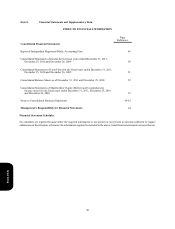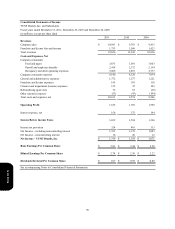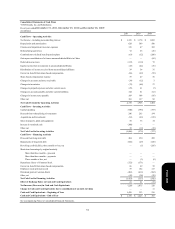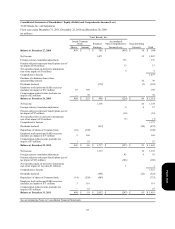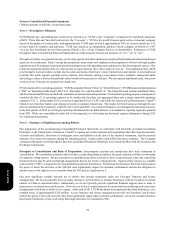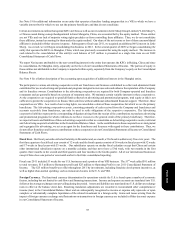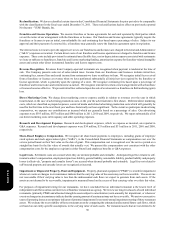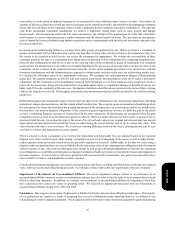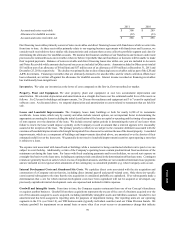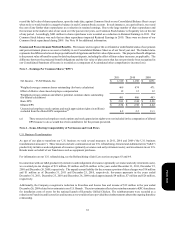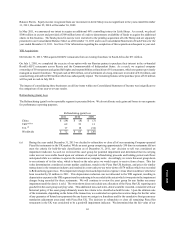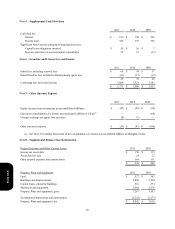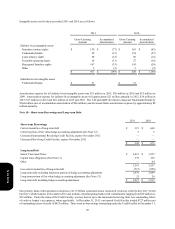Pizza Hut 2011 Annual Report Download - page 162
Download and view the complete annual report
Please find page 162 of the 2011 Pizza Hut annual report below. You can navigate through the pages in the report by either clicking on the pages listed below, or by using the keyword search tool below to find specific information within the annual report.
58
and upon subsequent renewals of such leases when we remain contingently liable. The related expense and any subsequent changes
in the guarantees are included in Refranchising (gain) loss. The related expense and subsequent changes in the guarantees for
other franchise support guarantees not associated with a refranchising transaction are included in Franchise and license expense.
Income Taxes. We record deferred tax assets and liabilities for the future tax consequences attributable to temporary differences
between the financial statement carrying amounts of existing assets and liabilities and their respective tax bases as well as operating
loss and tax credit carryforwards. Deferred tax assets and liabilities are measured using enacted tax rates expected to apply to
taxable income in the years in which those differences are expected to be recovered or settled. The effect on deferred tax assets
and liabilities of a change in tax rates is recognized in income in the period that includes the enactment date. Additionally, in
determining the need for recording a valuation allowance against the carrying amount of deferred tax assets, we consider the
amount of taxable income and periods over which it must be earned, actual levels of past taxable income and known trends and
events or transactions that are expected to affect future levels of taxable income. Where we determine that it is more likely than
not that all or a portion of an asset will not be realized, we record a valuation allowance.
We recognize the benefit of positions taken or expected to be taken in our tax returns in our Income tax provision when it is more
likely than not (i.e. a likelihood of more than fifty percent) that the position would be sustained upon examination by tax
authorities. A recognized tax position is then measured at the largest amount of benefit that is greater than fifty percent likely of
being realized upon settlement. Changes in judgment that result in subsequent recognition, derecognition or change in a
measurement of a tax position taken in a prior annual period (including any related interest and penalties) are recognized as a
discrete item in the interim period in which the change occurs.
The Company recognizes accrued interest and penalties related to unrecognized tax benefits as components of its Income tax
provision.
See Note 17 for a further discussion of our income taxes.
Fair Value Measurements. Fair value is the price we would receive to sell an asset or pay to transfer a liability (exit price) in an
orderly transaction between market participants. For those assets and liabilities we record or disclose at fair value, we determine
fair value based upon the quoted market price, if available. If a quoted market price is not available for identical assets, we
determine fair value based upon the quoted market price of similar assets or the present value of expected future cash flows
considering the risks involved, including counterparty performance risk if appropriate, and using discount rates appropriate for
the duration. The fair values are assigned a level within the fair value hierarchy, depending on the source of the inputs into the
calculation.
Level 1
Level 2
Level 3
Inputs based upon quoted prices in active markets for identical assets.
Inputs other than quoted prices included within Level 1 that are observable for the asset, either directly or
indirectly.
Inputs that are unobservable for the asset.
Cash and Cash Equivalents. Cash equivalents represent funds we have temporarily invested (with original maturities not
exceeding three months), including short-term, highly liquid debt securities.
Receivables. The Company’s receivables are primarily generated as a result of ongoing business relationships with our franchisees
and licensees as a result of franchise, license and lease agreements. Trade receivables consisting of royalties from franchisees and
licensees are generally due within 30 days of the period in which the corresponding sales occur and are classified as Accounts and
notes receivable on our Consolidated Balance Sheets. Our provision for uncollectible franchise and licensee receivable balances
is based upon pre-defined aging criteria or upon the occurrence of other events that indicate that we may not collect the balance
due. Additionally, we monitor the financial condition of our franchisees and licensees and record provisions for estimated losses
on receivables when we believe it probable that our franchisees or licensees will be unable to make their required payments. While
we use the best information available in making our determination, the ultimate recovery of recorded receivables is also dependent
upon future economic events and other conditions that may be beyond our control. Net provisions for uncollectible franchise and
license trade receivables of $7 million, $3 million and $11 million were included in Franchise and license expenses in 2011, 2010
and 2009, respectively. The allowance for doubtful accounts, net of the aforementioned provisions, decreased during 2011 primarily
due to write-offs and as a result of the LJS and A&W divestitures. Trade receivables that are ultimately deemed to be uncollectible,
and for which collection efforts have been exhausted, are written off against the allowance for doubtful accounts.
Form 10-K


